From the Slovenian Alps to Lake Balaton
800 kilometers through countless river valleys
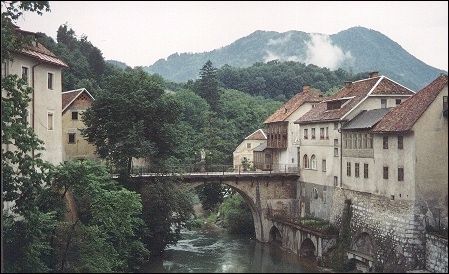
|
From the wild nature of the Alps to the crowded banks of Lake Balaton: a bicycle trip of almost 800 kilometers through countless river valleys. Leaving Slovenia and entering Hungary is a sea change: grander landscape, villages that are not as painstakingly neat and the people definitely more warmblooded.
Travelogue & photos: Piet de Geus
If you want to surprise the border police, you have to get up early. We haven't slept at all when we cross the Italian-Slovenian border at 5:30 am. The coach arrived in Tarvisio at 4 am and there we were, surrounded by darkness. The market town look pleasant enough: a mountain river runs through it and its streets look nice and intimate.
After two cigarettes dawn breaks and there is enough light to start walking with our bikes. Every now and then a whistling train stomps its way through the narrow valley. By the time the impressive surroundings become visible, it's light enough to mount our bikes. After a climb to a pass, we zip down between patches of fog to the border booth; the border guards stare at us with dropped jaws.
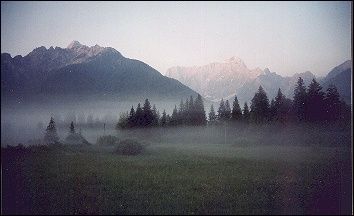
|
From the chilly morning fog rise, on the left, the Karawank Mountains and, on the right, the Julian Alps and the Triglav, whose peaks are already bathing in sunlight. At 6 am we already arrive in the famous ski resort Kranjska Gora, where we wait on a bench until we can get coffee and a room somewhere.
Kranjska Gora is ideal for hiking. The river Sava Dolinika finds its way between grit and shrubs. High above us a waterfall thunders down the green wall of the Karawank Mountains. Too high for us after a sleepless night, as are the mountain lakes of Triglav. We take a path through the fields back to the resort. The pastures are in bloom, here and there grass is being mowed and hung to dry on typical Slovenian hay racks.
National Park Triglav
Enclosed by one kilometer-high mountain walls
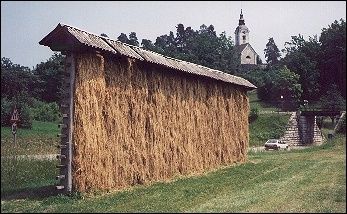
|
The road from Kranjska Gora to Jessenice was boring and straight, but we wish we were still there when we're climbing the 15 percent incline to Kocna. Once we reach the top, the route becomes beautiful: through the valley of the Poljana river, which ends at Lake Bled. The view of the lake and the island with a church at its center is stunning, but Bled is too touristy for our taste to want to stay here.
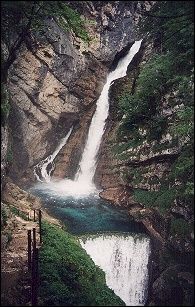
|
The road winds slowly up through the Sava Bohinjka valley to National Park Triglav, while the kilometer-high mountain walls close in on us. After we pass by Bohinjska Bistrica the walls open up to reveal the valley of Lake Bohinj. We find accomodation in a farmhouse that has been converted to a Bed & Breakfast. Nearby is an impressive waterfall which splashes down along the rocks from a height of 300 meters.
The surroundings again are wonderful for mountain hiking. We walk along the waterfall and - higher up - a series of mountain lakes and mountain huts to the 2864 meters high peak of the Triglav. But we don't reach it: just when we're walking around Lake Bohinjska Jezero the sky gets dark and the wind increases. It's a sign for us to get back to our B & B as fast as we can.
A short while later the rain storm begins. Every now and then we can't even see the lake. New clouds keep rising from the woods to unload their rain before they leave the valley. At a higher altitude avalanches of rocks thunder down and the sweet little stream next to the house has changed into a dark, swirling mass of water.
Historic town Skofja Loka
Baroque houses and medieval alleys and gates
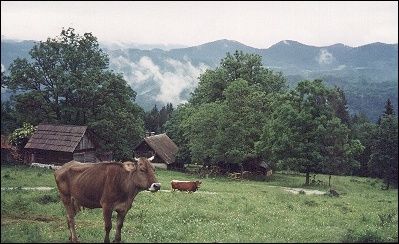
|
It has been raining for the last two days. Time to re-evaluate our plans. We wanted to bicycle along the slopes of the Karawank Mountains, which form the border with Austria, to Hungary, but in that region the rain also tends to stay for a long time.
We decide to take a route farther south to avoid the bad weather. So we ride to Bohinjska Bistrica in the drizzle and there we take a winding path up a hill. A few bends farther we have left Bistrica far beneath us. A deer on the road side stares blankly at us. Behind us we see that the Julian Alps and the Triglav are covered with a fresh load of snow. Between the woods are alpine meadows. After we have finished a 14 percent climb a group of farmhouses appears, which form the hamlet Bitenjska Planina.
Until we reach the pass at 1277 meters the road is unpaved for long stretches; sometimes we have to walk. At the pass we meet a group of road construction workers who are asphalting the road. We thank them for their beneficial work, mount our bikes and race down the slope. Immediately it gets freezing cold. We zip down along alpine meadows and - at a 16 percent decline - through a fir tree wood.
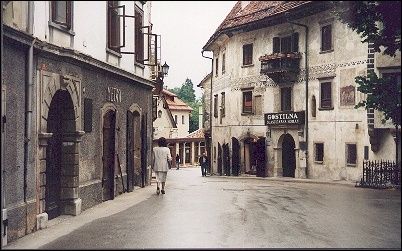
|
Crossing the pretty Selska Dolina (valley) we pass by picturesque rural villages like Sorica, Zali Log, Podrost, Zelezniki and Dolinjski Vas. We're not paying much attention, we gear up and push our pedals as fast as we can: we need a hot bath.
By 5 pm we arrive, after 70 kilometers, in Skofja Loka. Are we looking for atmospheric accomodation? Are you crazy? The concrete Communist-era behemoth Transit Tourist has rooms with warm baths and we can park our bikes in a locked market stall.
Skofja Loka has a well-preserved historic center. A Renaissance marketplace, Baroque houses and medieval alleys and gates make for an atmospheric environment on the banks of the Sora river. Early Sunday morning it's wonderful to wander around. The tourists haven't arrived yet and the Slovenians are in church.
A "room" in Ski Hotel Polzevo
"Yes, yes, cola-room"
It's only a two hour ride to Ljubljana on quiet rural roads. Mountains make way for hills, woods for more open landscape. The capital has a nice center, but it's as atmospheric as Dayton, Ohio. After lunch we immediately continue our route to the south.
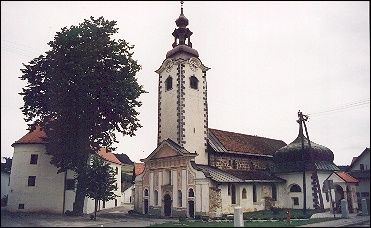
|
The surroundings become hillier and wooded again. It is still dry, which is encouraging: we take the 14 percent incline to Smarje-Sap with ease. There we take a picture of the church: every conceivable architectural style is incorporated in the building. It even has a Greek gable with painted columns.
Still snickering about the lack of taste of it all, we climb through dense fir woods to the ski resort Polzevo. When I ask for a room in the bar of ski hotel Polzevo, the bartender immediately gets it: "Yes, yes: cola room." The farmers who sit at the a big table grin at us: "Nazdrave!" No, no, I want a "Zimmer" (German for room). That they also have. Our bicycles are stored in the garage and guarded by a frightfully growling German sheperd. After our shower it's time to have a beer. We don't get a chance to order, the waiter already approaches - smiling - with two rum colas. Oh, well: Nazdrave.
Through valleys
Colorfully painted chapels along the road
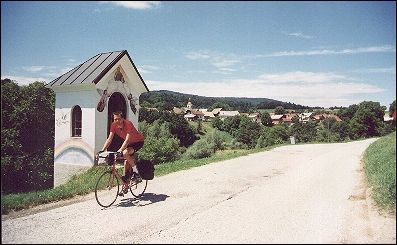
|
When we enter the valley of the river Krka the sun breaks through the clouds. Finally we can take off our jackets, sweatshirts and long bicycle trousers. Over hills we wave on a quiet road through the beautiful valley of the ever wider river, along many villages. In some bends of the river there are whirlpools
At regular intervals we pass by a barrage. We hardly notice the countless typical Slovenian hay racks anymore, but the colorfully painted chapels along the road get our attention.
In a Bed & Breakfast in Druzinska Vas our room has so much lace that we immediately name it the bridal suite. The ice-cold shower kind of ruins that imagery. Our evening walk to the famous spa Smarjeske Toplice nearby is a little disappointing. On the map it is marked as worth seeing, but it doesn't even remotely look like the atmospheric spas in the Czech Republic. A humongous, cold spa complex hovers over the hamlet, everywhere people in bathrobes walk around. The food makes up for some of it: mixed grill, fries, red beet salad en - most important - chocolate palacinki for dessert. Tomorrow we go back north in a wide bend.
Ptuj spa
Through a narrow valley between green walls
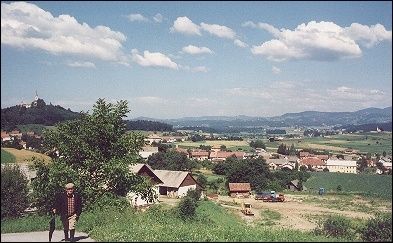
|
We bicycle through a green valley along diminutive hamlets to Mokronog, a nice rural village. After a short climb we descend into the narrow valley of the Mirna river, where we ride between green walls until we reach Sevnica. High above the town sits a large castle.
After Sevnica we follow another river: Sava. Most roads in Slovenia follow one of the countless rivers. The route through the Sava valley is pretty but also crowded. It is one of the thru ways to Zagreb and so there are lots of trucks. Every now and then we bicycle between impressive walls of rock.
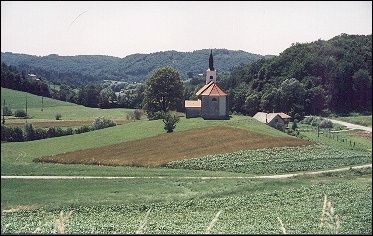
|
We spend the night in Celje, a moderately big town with a pretty old center and castle ruins.
The next part of our trip starts in the Vogljana valley, which we cross eastward. It's beautiful, but too crowded to enjoy it fully. That changes as soon as we leave the valley.
On the wooded hill which separates us from the Dravinja valley, we meet only a few trucks from a nearby quarry. After that, there is complete quiet, except when we pass by the machines that are asphalting the road.
Everywhere in this newly independent country work is being done to improve the roads, which means that we often have to walk on the roadside or on grit.
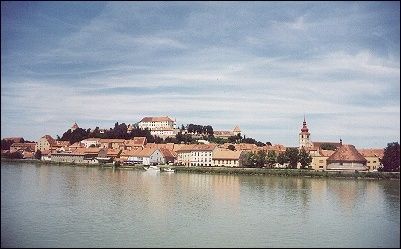
|
One more hill and we turn into the low plain of Ptuj, a city which is worth visiting for a couple of days.
The old city center is atmospheric and the 15th century castle, perched high above the town, is worthwhile. Apart from the usual exhibition of armor and weapons, it has a collection of old musical instruments. It is interesting to hear Chopin being played on the kind of piano for which he wrote his music.
Ptuj is rather touristy, but that can be entertaining, as we found out in the outdoor café on the pool. At the table next to us, four elderly Dutch people take over 15 minutes to pay their check. "No, Jan, use the change first." Four wallets are emptied on the table and a mountain of coins (1.5 cents and less) are counted. When they finally have the right amount, one of them says: "Let's count it again." While I almost choke on my steak, the whole show starts all over again. The waitress remains stoic, even though she understands that she won't get even a penny tip from this table.
Keszthely on Lake Balaton
The Hungarian border guards greet us with "Holland!" from afar
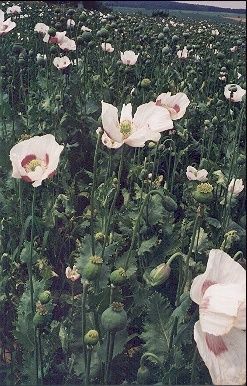
|
The temperature has risen to around 30 degrees Centigrade. The pool has done wonders for our muscles. So we bicycle in an excellent mood between vineyards toward the Hungarian border. The first storks are a sign that we're approaching that country. To be quite honest, we've had it with Slovenia. It has beautiful landscapes, nothing wrong with that, but the villages are as painfully neat as those in Swiss or Austria. Those are the countries that Slovenia takes for its model: an important motivation for independence was that they didn't want to be part of the Balkans.
In comparison to the Balkan countries Slovenia is rather colorless indeed: except for the hay racks we were unable to find anything typically Slovenian. The people are mainly polite. The price level is comparable to that of Austria, while Slovenia doesn't have Austria's level of tourism development by far.
The Hungarian border guards - known for their grumpiness - greet us from afar with "Holland!" when we approach on our bicycles. They immediately ask where we're from, how many kilometers we have bicycled and where we're headed. Spontaneously they show us a quiet route. This much interest and unfeigned friendliness we haven't experienced in two weeks in Slovenia.
We bicycle to Keszthely, the best preserved town along Lake Balaton, along vast grain, corn, poppy and sunflower fields. It's humid, there is a thunderstorm in the air, and the route is hard: again and again a climb of a hundred meters and then a descent of hundred meters. So one never finds a steady pace. Quote of the day: "We've reached the top." (100 times bis) On the way we pass by tens of stork nests.
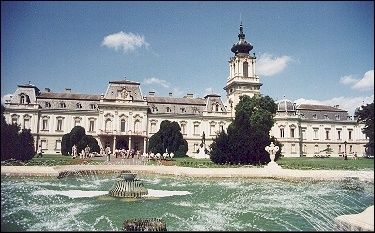
|
In Keszthely we easily find a large room. Our hostess, an advertisement photographer, immediately serves us coffee under the peach trees in the garden.
When she sees my camera, she goes into the house and returns with a stack of photos. The house belongs to her senile mother, who used to be a famous photographer in Budapest. The prints are perfect indeed.
Keszthely is rather touristy, but most tourists stay in a small section of the town center and they spend their nights in vacation homes or on camping grounds along Lake Balaton. Keszthely has picturesque streets, a large palace with a beautiful garden and a nice museum of the agrarian history of Hungary. Food is cheap outside the town center. If you look, you can find places which have goose liver with excellent wine for only a few euros, accompanied by a live gypsy orchestra. Nut palacinki with chocolate sauce costs less than a euro.
Vézprem
On the way we pass by Szentkiralyszábadje
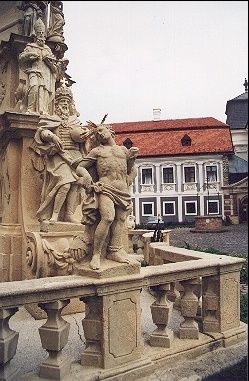
|
The way to Balatonalmadi, where we will board the coach back to Holland, is boring. The road along Lake Balaton is crowded, the villages are tourist traps and the beaches are occupied by Germans who remind us in more than one way of walrus colonies. Balatonalmadi is also a place where you even wouldn't want to be buried. But we find a room in a quiet section, from where we can explore.
Ten kilometers inland, behind a hill top, is Vézprem, which has a beautiful old town center. On the way you pass by a village whose name you should try to pronounce ten times in a row: Szentkiralyszábadje.
In an outdoor café in Vézprem we are treated to a scene from John Cleese's Fawlty Towers. A student rapes Demis Roussos on a Yamaha organ. The waiter is completely confused. None of the orders are right, he forgets half and of the other half he doesn't remember who ordered what. So he keeps asking "Who ordered..." He sounds more like a market vendor than like a waiter. When we ask for an ashtray, he brings us matches. He gives his colleague an espresso that nobody ordered. Or so it seems: two Germans arrive and both order espresso. The waiter sprints to his colleague: the espresso! He snatches the espresso from his colleague's hands and brings it to the Germans: "Diese ist schon fertig!" Everyone on the terrace laughs, but the waiter doesn't understand why.
Tihany Park
Walking along a wealth of flowers
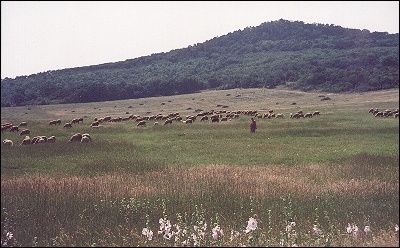
|
From Balatonalmadi a ferry leaves for Tihany, a village on a steep hill with a monastery and old farmhouses with thatched roofs. Tihany is also the name of the peninsula on which the village sits in a protected nature reserve.
As soon as one leaves Tihany, there are no more tourists. Just outside the village is Belsó-tó, a pretty lake with frogs. Around the lake are meadows with wild flowers; on the path marmots scuttle away from us. We walk along a wealth of flowers at first, later between vineyards. A shepardess wanders through the fields with her flock of sheep. On cart tracks, through woods and along another lake, we leave the peninsula.
On the train from Aszofó back to Balatonalmadi we discover the origin of the rail tender: a Hungarian in khaki shorts pushes a rattling shopping cart with a thermos can of coffee covered in a centimeter thick layer of coffee grounds. The rest of the cart is filled with bottles of beer. On the lower tray there is a crate of beer, just to be on the safe side. The Hungarians will make sure that the beer is gone before it gets a chance to warm up. We are curious if the chauffeur of the Dutch coach service which will pick us up tomorrow, can match this service.